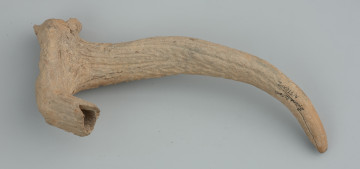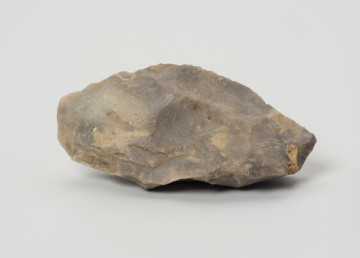
Holder
9600 p.n.e. — 5400 p.n.e.
National Museum in Szczecin
Part of the collection: Stone Age
The Kongemose antler axe was discovered in Szczecin, probably while dredging the Oder River in the late 19th century. It comes from the collection of the former Gesellschaft für Pommersche Geschichte und Altertumskunde in Szczecin. The raw material was the beam of a large, healthy and robust male red deer. The surface shows traces of intensive use, both on the blade and the hilt. These traces (dents, breaks, cracks) suggest its use for various activities, including woodworking and probably digging. The axe also bears traces of multiple repairs, mainly adjustments to the blade. The multifunctionality of the tool described above is typical of hunter-gatherer communities in northern Europe. Due to their nomadic lifestyle, people tried to limit the weight and number of items they carried. Hence, the need to produce multifunctional and composite tools could be easily disassembled and replaced by worn out or currently unnecessary elements. Axes of this type are characteristic of the Mesolithic, the Late Maglemose culture and the Kongemose culture.
Michał Adamczyk
Author / creator
Dimensions
cały obiekt: height: 26.1 cm, width: 6.9 cm
Object type
axe, hatchet
Technique
cutting, drilling, planing, scraping, breaking, setting, softening
Material
red deer antlers
Origin / acquisition method
acquisition
Creation time / dating
Creation / finding place
Owner
National Museum in Szczecin
Identification number
Location / status

9600 p.n.e. — 5400 p.n.e.
National Museum in Szczecin

9600 p.n.e. — 4100 p.n.e.
National Museum in Szczecin

7800 p.n.e. — 7000 p.n.e.
National Museum in Szczecin
DISCOVER this TOPIC
Museum of King Jan III's Palace at Wilanów
DISCOVER this PATH
Educational path